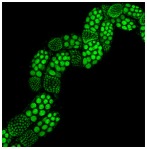Kaleidoscopic view of nurse cells in the ovaries of Microplitis demolitor (a parasitic wasp).
This story has two players:
The Helicoverpa (aka heliothis), which is a serious pest of southern Queensland crops, particularly grain legumes, summer grains and cotton.
and
The Microplitis demolitor, a small native wasp.
The wasp plays a surprising but beneficial role in keeping the destructive caterpillar population in Australia in check.
It does this in two ways. I am going to refer to them as follows:
1. The Ridley Scott’s Alien method.
Microplitis is a parasitoid. A parasitoid is an insect that kills its host to complete its life cycle. Parasitoids are usually described according to the life stage of the host that they attack. Microplitis wasps are called larval parasitoids because they lay their eggs inside small helicoverpa caterpillars. The eggs hatch within the caterpillar and the larvae grow and develop inside the living caterpillar by feeding off its internal organs. When they are ready to hatch they chew through the body of the caterpillar and explode from their lifeless carcass.
Someone should make a movie out of that.
2. The STD method
Ascovirus is a virus that is deadly to helicoverpa caterpillars. A female Microplitis wasp lays her aforementioned eggs inside a caterpillar by penetrating it with her oviposter (stinger). If the penetrated caterpillar is already infected with the ascovirus, the wasp picks it up on the end of her oviposter. She then selects another caterpillar to penetrate and in doing so infects it with her pox ridden penetrator. In her lifetime this girl will stick that thing inside, and potentially infect, around 75 caterpillars.
There may or may not be a hidden moral to this story.
Image source: Muthugapatti K. Kandasamy of the Biomedical Microscopy Core at The University of Georgia.
Narrative by i-heart-histo adapted from Insects by the Queensland Government, Australia.
Don’t have nightmares.


